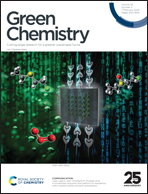Production of 5-hydroxymethylfurfural from fructose via inherent catalytic properties of a biphasic system without external catalyst addition
Abstract
5-Hydroxymethylfurfural (5-HMF) is the key to unlocking the potential of biomass materials to transform into fuels, materials, and chemicals. In this study, an effective biphasic reaction system composed of a reaction phase (aqueous phase) and an extraction phase (organic phase) was used for the conversion of fructose to 5-HMF. Deep eutectic solvents (DESs) composed of different hydrogen bond donors and hydrogen bond acceptors, the ionic liquid [BMIM]Cl, aqueous choline chloride, aqueous betaine hydrochloride, and ethylamine hydrochloride were used as the reaction phase, and different organic solvents, such as methyl isobutyl ketone (MIBK), dimethyl sulfoxide (DMSO), toluene, ethyl butyrate, and gamma-valerolactone (GVL), were used as the organic phase. Experiments were conducted under optimal conditions simulated using the reaction surface method to obtain the maximum 5-HMF yield. The highest yields of 5-HMF obtained in reactions with DESs were 67.86%, 68.69%, and 71.40% for ChCl : OA, ChCl : Lac, and EaCl : Lac, respectively. However, adding dimethyl sulfoxide and betaine hydrochloride aqueous solution to the fructose conversion system resulted in a maximum yield of 90.42% ± 1.46% of 5-HMF without the use of catalysts. This study also demonstrated that betaine hydrochloride could be effectively reused four times. A 5-HMF yield of at least 80% indicates a green process suited towards sustainable development.



 Please wait while we load your content...
Please wait while we load your content...